One evening, about a week after the military coup in Myanmar which overthrew the democratically elected government led by Aung San Suu Kyi, ending a process of democratisation of the country after ten years of relative liberalization, “M” sent a message on a social media discussion group linking students and teachers from his graduation year. “Teachers, I want to ask something,” he wrote. “I am sitting here, I am thinking and I cannot sleep. I am involved in the overthrow of the dictatorship. Does it break the ethic of not taking sides as a journalist?”
The next morning, one of his former teachers replied: “Under the military dictatorship, we cannot hope to fulfil our role as the fourth pillar of democracy.” One of M’s former classmates joined in: “It is against the military dictator […] We must be neutral in journalism, but we must defend the truth. Under the military dictatorship, they were not even allowed to present the truth.” She advised ‘M’ to communicate via the encrypted messaging service Signal and sent him a list of precautions to take while covering the protests, based on a translation of notes originally prepared by pro-democracy activists in Hong Kong.
Another member of the discussion group added: “It's not about being an activist. They demand the rights of a citizen that everyone has the right to demand. But it might be good that the current journalists are not involved in this movement because there is a risk for your media. What do you think about this?”
‘M’. replied: “I was encouraged to see the messages from the teachers. I think that in the beginning I will continue to post.” The following day he went about finding a digital platform on which he could publish the photos of pro-democracy street protests around Myanmar.
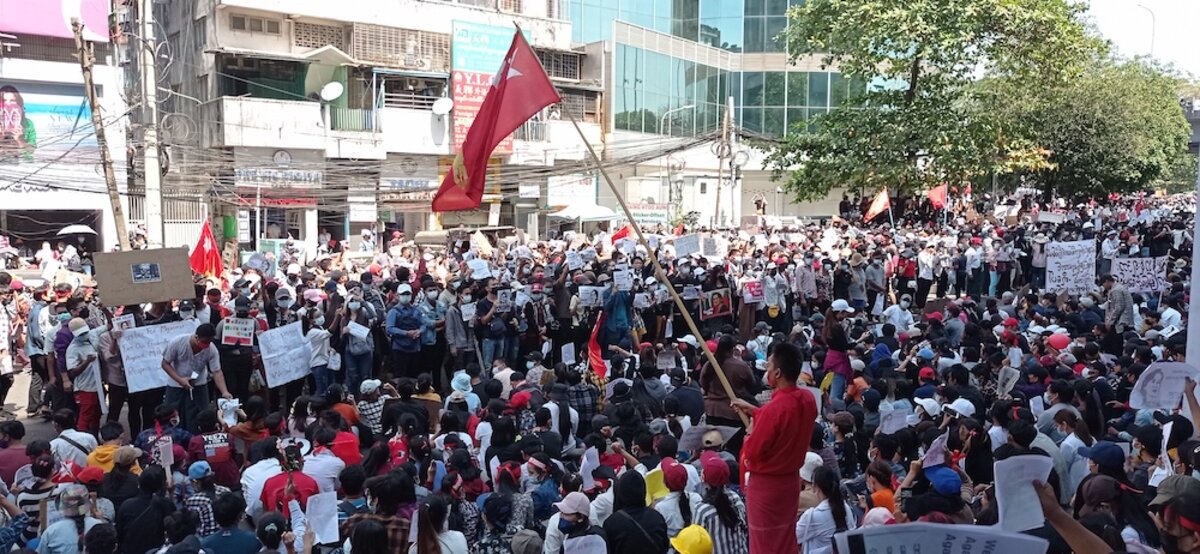
Enlargement : Illustration 1

“I went into the street because I need to take pictures for my blogs and because that is my job,” explained ‘M’ in a written exchange for this report. “I was afraid at first I wouldn't be able to produce balanced news (between protesters and the authorities). Our teachers told us at school that if we are journalists, we cannot take sides, but right now, they are saying that we are on the same side [as] the public. Because we were born in this country and what happened has an impact on all of us.”
As arrests of opponents of the military coup continue, and the repression of street protests intensifies across Myanmar, the identities of the reporters and photographers interviewed here are withheld. All of them are known to Mediapart, and they were interviewed directly by encrypted messaging.
More examples of their photo coverage of the civil unrest can be found in the “Club” column on the Mediapart English homepage.
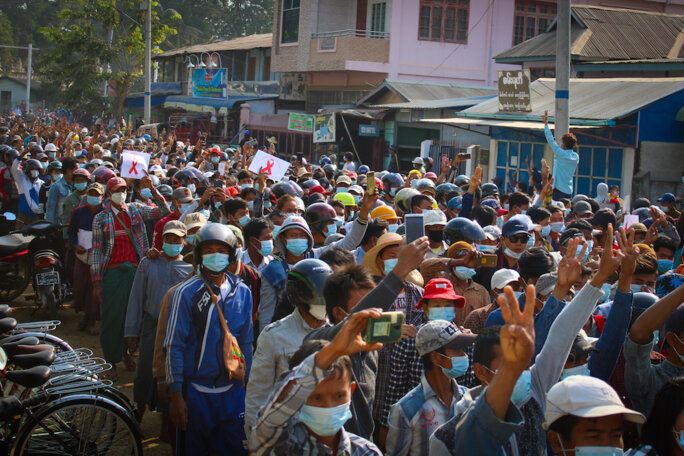
Enlargement : Illustration 2

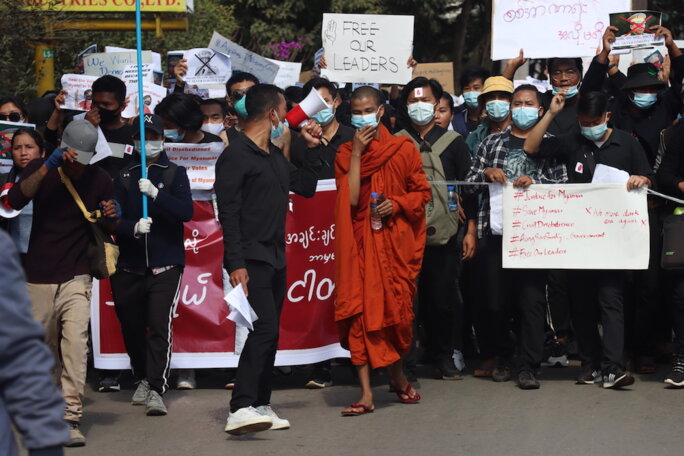
Enlargement : Illustration 3

In the spring of 2020, as the coronavirus pandemic took hold, all students were sent back to their home regions. Now, from the plains of the Irrawaddy river that runs north to south through Myanmar, to the states of Shan and Rakhine, to the east and west of the country, and also the economic centre and once capital city Yangon (the former Rangoon), around ten young reporters have been uploading their images of the civil resistance on Facebook and Instagram, as correspondents for local media and out of personal interest.
One of them, “K”, lives in a hamlet in Upper Myanmar, and the upheaval of the protests offered a rare opportunity to swap online courses for some real-life reporting. “People go to the fields before dawn and come back before dusk,” recounted ‘K’. ”Except for their fields, they don't care about anything, not even Covid-19, because there are very few cases registered here. But on the morning of the coup, everyone was so shocked when I woke up! I can't believe what happened. It's bloody absurd."
About a week after the February 1st military coup, ‘K’ travelled by moped to Salin, a small town with a population of around 13,000. “I had never seen such a crowd, people came from everywhere, there were more than 20,000 of them if I am not mistaken,” said 'K'. “This Saturday, we are expecting even more people for Bogyoke Aung San's birthday in Magway, his birthplace.”
An independence hero who is widely considered as the founding figure of the nation, Bogyoke Aung San, the father of Aung San Suu Kyi, was born on February 13th in the town of Natmauk, in Magway Region of central Myanmar. Aung San, who founded the country’s armed forces, negotiated the independence of Burma, as Myanmar was then called, from British colonial rule. In July 1947, six months before independence was officially declared, when, as premier of the “British Crown Colony”, he was holding a meeting with his cabinet, gunmen broke into the room and shot dead Aung San and seven others. He remains a widely revered figure in Myanmar, as popular as his daughter who is now under house arrest and charged with possessing illegal walkie-talkies and violating the country's Natural Disaster Law.
Seeking out the facts behind rumours
The young journalists have reported on a large and very diverse turnout in the protests across the country, which have brought onto the streets farmers, truck drivers, miners, medical staff, teachers, members of the judiciary and LGBT+ activists. “Every day, the signs became better made and there were trends, such as dressing up as a ghost, a clown or a cosplayer for attention and adding fun,” reported “H”, who is from Thandwe, a large port city in the western state of Rakhine. “Today, many doctors, teachers […] and engineering students, joined us.”
For many of the group of budding reporters, it is their first experience of covering demonstrations. ‘K’ regrets not being able to “take better pictures” in Yangon (the former Rangoon), the county’s most populous city and which was its capital until 2006, when the then ruling military relocated the centre of power to Nay Pyi Taw. From his base in Upper Myanmar, the young man, who wants to establish himself as a photo-journalist, found himself thrown into the deep end of reporting. “I was excited, but I didn't know where to start or what position to take to take good pictures,” he commented. “I guess wide-angle would have been more appropriate for this moment, but I only have an 18-55 mm lens. I solved my problem of depth by asking a driver if I could climb on top of his car.”
‘M’ covered the first demonstration in the centre of Yangon, uncertain of what he would find. "The first day I went there, I don't know what I should do so I just look around and I walk,” he wrote. “I have to think about how to take pictures and about security. Now I check on social networks where the most interesting scenes are happening. And if I hear a 'bang', I run and hide.”
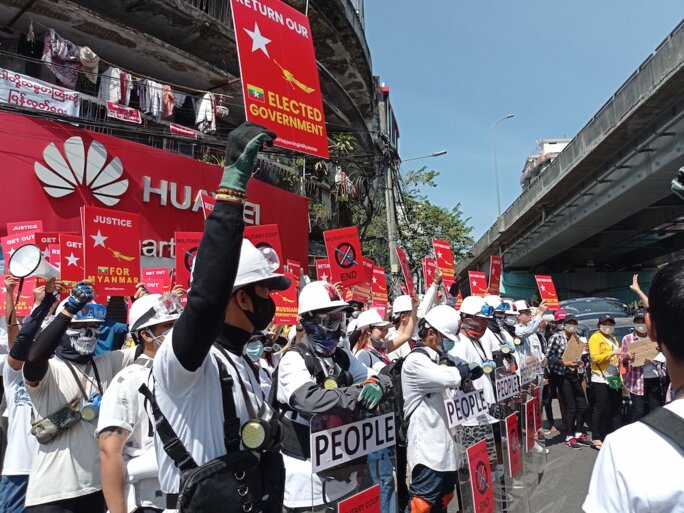
Enlargement : Illustration 4

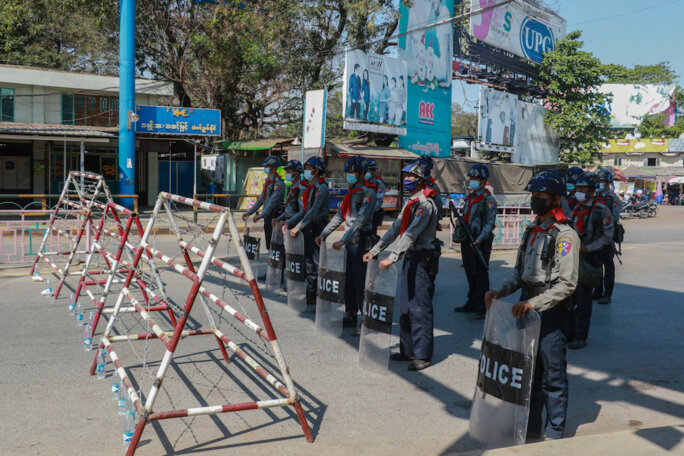
Enlargement : Illustration 5

On February 9th, the police used live rounds as well as rubber bullets and watercannon on protestors in Yangon, in Mandalay (the second-largest city), and in the capital Nay Pyi Taw, where supermarket worker Mya Thwe Thwe Khaing, 19, was hit in the head by a bullet that day as she hid behind a bus stop. She died on February 19th, after being declared brain dead and spending ten days on a life support machine. She was buried in the capital on Sunday, when huge crowds turned out along the route of the funeral cortege.
After the report of the shooting of the young woman, ‘H’ wrote:“I am sad for the girl but I am not scared. The feeling of going to demonstrations every day and reporting has not changed. Because I am not alone, people are moving all over Myanmar. At the moment, I'm sending news to my fellow reporters and the main thing is to take photos of the news.”
Another member of the young reporters’ collective is “Z”, based in the south-central Bago Region. “There are only five reporters in our town, so the township police chief knows us very well,” he recounted. “But now [it] is under military rule. I was scared of being arrested, but I couldn't help but shoot [pictures] when I was in front of the police barricades. I shoot better day by day. I started working as a journalist for the youth channel of a local media in 2018. It was difficult at home and I thought that taking photos could be an interesting way to make a living and tell our story […] I will send my photos every day until the end of this movement.”
‘M’, meanwhile, expressed frustration over the difficulties in verifying the numerous rumours that abound, such as one claiming the military are paying people to appear in counter-protests in order to pretend the coup also enjoys support among the civilian population. “The rumour is that they have been hiring people for 5,000 Kyats [editor’s note, about 3 euros] per person per day,” he wrote. “The evidence of them hiring pretend-supporters had spread on the internet days ago. No one knows who is the original source. Since it got all out, the military has been finding the people they had hired in order to shut them up. A few people's families say it's been days since they last had contact with them (the fake supporters) and are worried about them. Several rumours say those people were killed. We need more facts of that.”
Swe Win is the editor-in-chief of Myanmar Now, a Yangon-based independent news agency that syndicates reports in Burmese and English. It has exposed the conflicts of interest of the military's leader, general Min Aung Hlaing, and his family (see here and here). Win was the target of a gun attack while holidaying in December 2019 in the western Myanmar state of Rakhine, when he was hit in the leg. He and his family subsequently left Myanmar and are currently still in exile in an undisclosed location.
Earlier this month, following the coup led by Aung Hlaing, Win gave an interview to the Columbia Journalism Review, when he was asked if he thought the current protests will have an effect on the military. “I don’t think so at all,” he said. “The military knew how to deal with these protests, how to deal with public opposition. They have already started big-time information warfare, psychological warfare against the public. They have cut off all the internet. Yesterday, the vigilante groups hired by the military, they went around a neighbourhood in trucks saying Aung San Suu Kyi was already released. People flooded the streets to celebrate the rumour of the release; they lit firecrackers. So I’m not hopeful about these ongoing protests, even though I congratulate [the people], even though I feel emotional about the bravery of the youth.”
'Access to the internet has become a human right'
Among the rumours spreading in Myanmar, and relayed on social media, is one that claims the military are poisoning drinking water tanks. Others talk of released prisoners and youths high on drug, transported by lorries and ambulances, being paid to carry out arson attacks in some of the country’s larger towns. Neighbourhood patrols have been created to prevent such incidents and also against overnight arrests by police.
On February 12th, the military authorities pardoned en masse around 23,000 prisoners serving lengthy jail sentences, including some on life terms and others awaiting execution. Among the released were those found guilty of participating in the January 2017 assassination of lawyer Ko Ni, a Muslim and member of the National League for Democracy party led by Aung San Suu Kyi, for whom he served as a legal advisor. He was shot dead in broad daylight at Yangon International Airport when returning from a trip to Indonesia.
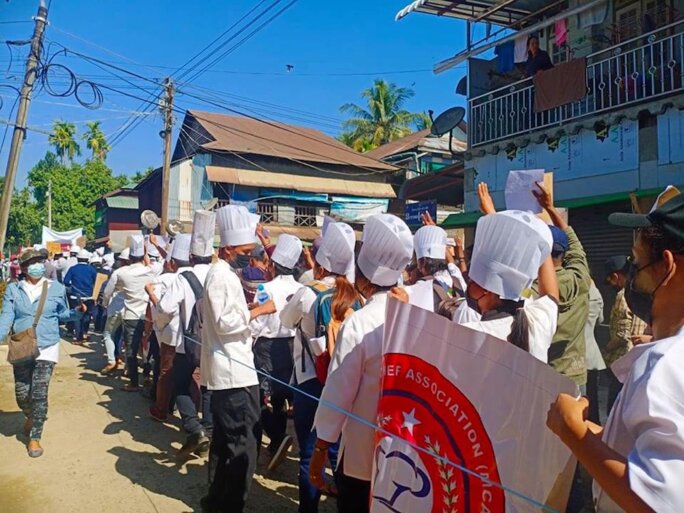
Enlargement : Illustration 6

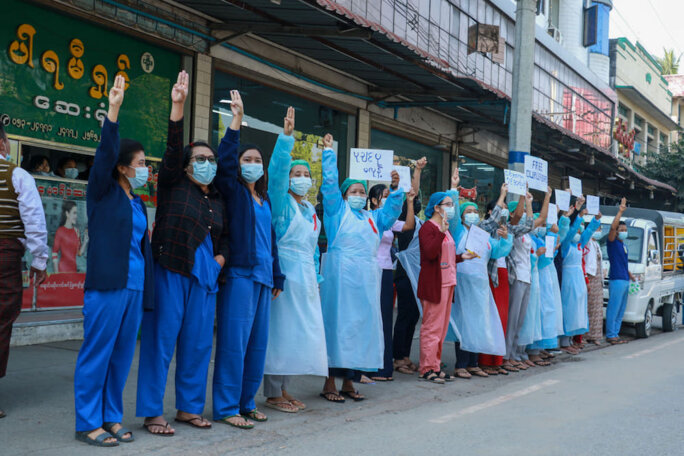
Enlargement : Illustration 7

“The ruthless junta is sending thugs for arson attack at middle of the night to residential areas,” wrote Kyaw Win, executive director of the London-based Burma Human Rights Network, in a Twitter post on February 12th. “Local people have detained them but decided not to handover to the police. This is quite similar to 88 uprising. Very scary." He was referring to the mass national movement of protest from March to September 1988 against the strongman, one-party regime of general Ne Win, which ended with a military coup when, according to unofficial estimates, thousands died.
On February 12th, when the nationwide protests saw numerous clashes between demonstrators and police,‘H’ witnessed the violence in the port city of Thandwe: “I regret not staying to take pictures (when the police truck hit the motorcade), but my mother, who was demonstrating with her friends, was very worried, so we left. There were some arrests of student leaders, but most of them were released when the people went to protest outside the police station.”
The state of Rakhine, in which Thandwe is situated, runs along Myanmar’s western coastline and up to Bangladesh in the north. It has for many years been subject to inter-communal conflict, and was latterly the scene of the notorious ethnic cleansing of the Rohingya people which caused international outrage. The troubles began with frequent violent clashes between the Rakhine Buddhist majority population and the minority Rohingya people. Continuing skirmishes between Rohingya armed rebels and the Myanmar military culminated in the launch by the latter of the ethnic cleansing campaign, in which the UN accuses army officers of organising mass killings, rapes and arson, and which saw the displacement in 2017 of about 730,000 Rohingya who fled to neighbouring Bangladesh. Meanwhile, the military has since also been fighting Buddhist insurgents, the Arakan Army (“Arakan” being the demonym of the inhabitants of Rakhine), who want greater autonomy for the region.
Reporting this month from the north of the state, ‘T’ observed: “Rakhine people, especially from northern Rakhine, think this movement [of opposition to the coup] doesn't concern them. Because of civil war in Rakhine for two years, that divided central Burma and ethnic Rakhine, people don't feel involved in what is happening in Yangon and the rest of the country.”
‘T’ was also in Sittwe, the capital of Rakhine, where he reported on the liberation of two longstanding local pro-Rakhine autonomous movement activists, Aye Maung and writer Wai Han Aung, who in 2019 were sentenced to 20 years in jail for their alleged support of the Arakan Army. “Dr. Aye Mg and Author Wai Han Aung were released today from Inn Sein Prison, where they were for three years,” reported ‘T’. “They had been sentenced for 20 years due to speech considered anti-national at a literature festival.”
‘T’ is a former activist with an NGO working in the region, where access to the internet was cut in nine districts between June 2019 and February 2021, officially for reasons of “disturbances of peace and use of internet activities to coordinate illegal activities” .
‘T’ reported: “Access to the internet has become a human right, which has been repeatedly taken away from us, preventing us from informing and educating ourselves, communicating and publishing evidence of abuse of civilians.”
There are fears that the blackout of the internet in Rakhine is the precursor of what will be a blackout across the country, along with the monitoring of all attempts to connect with the internet. “I always delete the boxes after I post something and I use a VPN with VIP access,” reported ‘M’. “But I'm scared of the coming internet cut, I have a lot of back-up but I'm not sure it will work or not.”
‘Z’ commented: “It is dangerous to use our names and most of the media in Myanmar have already decided to stop [putting] credits on the images. But the international press must continue to know. I will go every day to take pictures and send them when I can and I want to contact the UN as soon as possible.”
In his interview with the Columbia Journalism Review earlier this month, Myanmar Now editor-in-chief Swe Win was asked where did his reporters go after his newsroom closed down, while he was no longer in the country: “Even though I foresaw the coup, I did not foresee the brutal way it would be launched. So before the coup, they all stayed in their houses, and then, within five hours of the coup, I ordered all my colleagues to leave their houses and stay somewhere with their families or their friends. Half of the team did not want to accept my idea because they were outraged, as equally as members of the public. ‘Why should we leave? We’ve got to do what we’ve got to do.’ If I worked in Yangon, I would not shut down the newsroom. I would not ask them to flee. I would keep operating the newsroom, no matter what the consequences. But since I’m out of the danger zone, I have the moral obligation to take precautionary measures.”
Asked how his newsroom can operate now, he replied: “Half of the team is now back at work. They are going out from their hideouts to cover the protests. It would be a shame if we missed the entire public opposition. It would be psychologically devastating to all of us – we’d feel very irresponsible – so I put half the team back at work. But still, we’re in disarray. They’re still grappling with the trauma of the coup.”
“I’m talking with our donors about whether there’s a possibility of setting up the newsroom in a neighbouring country,” he added. “Many journalistic colleagues won’t want to work for a newsroom in Myanmar. They will have to accommodate the junta; they will have to adjust their coverage to the reality of military rule. There will be a lot of injustices, tons of stories to cover.”
In a letter addressed to the Myanmar Press Council, an officially appointed body for mediation in press matters, the military junta warned that any media reference to a “putschist government” following the coup this month would be the subject of prosecution and the revocation of their publishing licence.
For ‘M’, the current great uncertainty of where events will lead may demand tough decisions. “I think this revolution will not easily end,” he wrote. “If the public lose the coup, all the media in this country will be finished or become [the state-controlled] MRTV and Myawaddy News fake news channels, and our country will be fifty percent the same like North Korea. If that happens, I will move outside of the country."
-------------------------
More coverage by The Myanmar Project, posted by Laure Siegel on her Mediapart blog, can be seen here, here, here, here and here.
- The original French version of this report can be found here.
-------------------------
If you have information of public interest you would like to pass on to Mediapart for investigation you can contact us at this email address: enquete@mediapart.fr. If you wish to send us documents for our scrutiny via our highly secure platform please go to https://www.frenchleaks.fr/ which is presented in both English and French.
-------------------------


